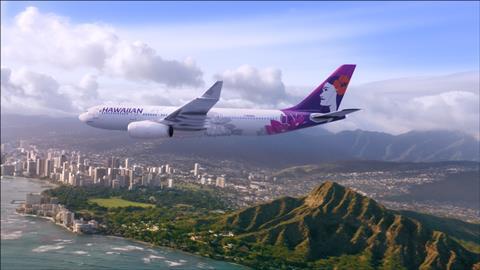Hawaiian Holdings, parent company of Hawaiian Airlines, reports narrowing its fourth-quarter loss as demand for air travel to the Pacific archipelago has largely rebounded – except from Japan.
The Honolulu-based carrier reported on 31 January losing $50.2 million during the final quarter of 2022, compared with a $92.6 million loss during the same quarter of 2021, amid widespread travel restrictions related to Covid-19.
For the full year of 2022, Hawaiian lost $240 million, compared with a $145 million loss for 2021.
“It’s encouraging to be entering a year where Covid restrictions are no longer hovering over our network,” Hawaiian’s chief executive Peter Ingram said during the airline’s quarterly earnings call on 31 January. “But we know that we have a lot of work ahead of us as our financial performance remains quite a ways from being recovered.”

Total revenue for the fourth quarter came in at $731 million, up from $495 million in the fourth quarter of 2021.
The airline reports robust travel demand to Hawaii from North America, and demand recoveries from other key markets in Australia, New Zealand and South Korea.
“Having said that, despite the removal of Covid travel restrictions in October, Japanese travellers have not yet resumed international travel at a pace comparable to pre-pandemic levels,” Ingram says. “While we remain confident that the long-standing affinity of Japanese travellers for Hawaii vacations will manifest, we also need to be pragmatic about putting capacity elsewhere if recovery remains slow.”
The airline struggled in the fourth quarter with on-time performance to its Honolulu hub due to construction on primary arrival runways and “air traffic control programmes that constrain arrivals into the airport”, Ingram says. The limitations have primarily affected Hawaiian’s short-haul flights to neighbour islands.
“As a consequence, our reliability has fallen below our high standards,” Ingram says. “We have been forced to make adjustments to our schedule to stabilise operations.”
“For 2023, the focus is on operating more reliably, consistently and efficiently,” he adds.
Hawaiian is also feeling competitive pressure from Southwest Airlines, which started offering inter-island Hawaiian flights in April 2019. Ingram called the rivalry a “neighbour island competitive battle” on 31 January but insisted that Hawaiian maintains an edge, despite Southwest often undercutting its fares.
“We continue to believe that our place in the community, our product and schedule, our knowledge of the guest and our fabulous employees give us structural advantages here that will enable us to win,” he says. “We are Hawaii’s airline.”
Looking ahead to the first quarter of 2023, the airline anticipates that operating revenue per available seat mile will be up from 7.5% to 10.5% compared with the three months ending 31 March 2022. But Ingram declines to predict when the carrier will return to profitability.
“I can’t project the timing of a return to profitability as precisely as I would like,” he says. “We don’t control the timing of demand recovery from Japan.”
This year, Hawaiian will begin operating at least 10 Airbus A330-300 freighters on behalf of Amazon. The airline also expects in the fourth quarter of 2023 to accept delivery of the first of 12 Boeing 787-9 Dreamliners it has on order.
“As we start up our new Amazon service and enter the 787s into service, we will reap the revenue benefits and grow shareholder value,” says Shannon Okinaka, Hawaiian’s chief financial officer.


























